This post was originally published on this site
The winter season isn’t as cold as it was roughly 50 years ago, especially in the U.S. Northeast and for Great Lakes cities, including Chicago. The Lake Michigan metropolis just broke its record for the latest start to the snowy season.
That means Chicago and other areas often welcoming a “white Christmas” will be hard-pressed this year to enjoy just such an aesthetic.
There have been traces of snow this fall and winter in Chicago, but there’s been nothing “measurable” by National Weather Service standards. Previously, the latest Chicago recorded measurable snow in a season was Dec. 20, 2012. On average, the city can get out its yardstick on Nov. 16. The holiday forecast (this Chicago-based reporter has double-checked) is for no snow come Friday or Saturday. Rain, yes.
Chicago is not unique, as the impact of climate change is shifting seasonal starts and stops, according to some scientists.
Using winter temperature data from 1970 to 2021 in 246 locations across the U.S, Climate Central, a consortium of climate scientists and journalists, reports that about 98% had an increase in their average winter temperatures over five decades. And 84% (202 of 241) of those locations have warmed by 2°F or more.
The five greatest increases are seen in Burlington, Vt. (7.2°F), Concord, N.H. (6°F), Milwaukee (6°F), Chattanooga, Tenn. (5.8°F), and Green Bay, Wis. (5.8°F).
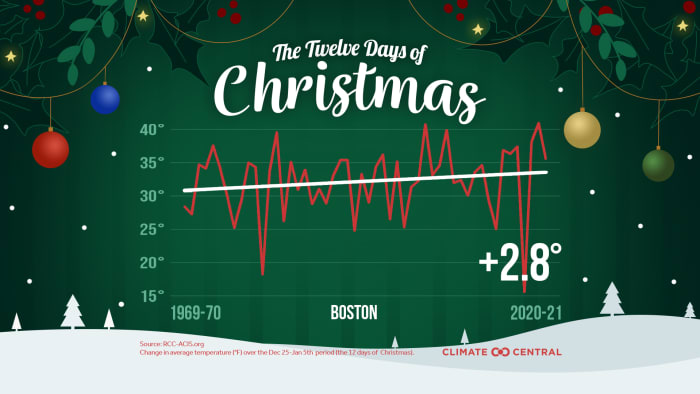
Climate Central
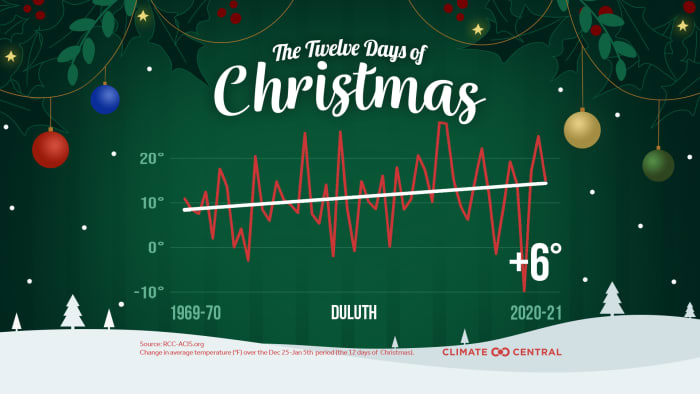
Climate Central
Since 1970, winter is the fastest-warming season for most of the U.S. All seasons are feeling the effect of climate change, but a Climate Central analysis shows that over the past 50 years, average temperatures increased more in winter than in any other season for 38 out of 49 states (excluding Hawaii).
Some climate scientists stress the necessity of tough scrutiny of snowfall trends because temperature alters snowfall in two different ways. In warmer borderline areas, warmer air turns snow into rain. But in cooler, more-northern areas where even higher temperatures are still below freezing, warmer temperatures bring more snow because warmer air holds more moisture, and that moisture falls as snow.
Warmer average winters still can pack dangerous cold snaps, in part because climate change worsens extremes. Still, a tedious refrain often circulates when the temperature plunges: “What global warming?”
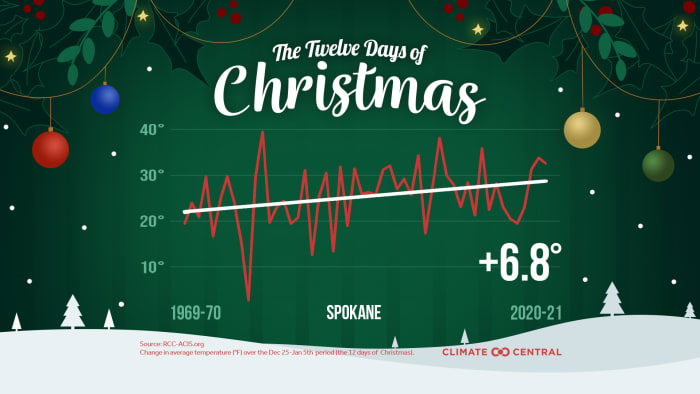
Climate Central
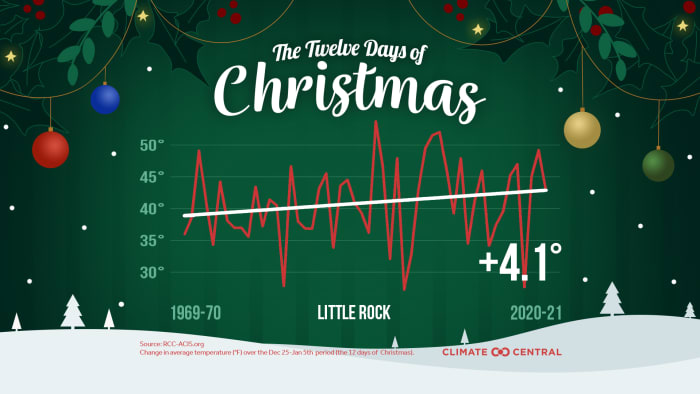
Climate Central
Another factor is the limitations of human memory, our fondness for nostalgia and what may be the arbitrary significance attached to experiencing Christmas in a winter wonderland, which of course has never been a feature in the warmer climates where the holiday is celebrated around the world.
In fact, the National Oceanic and Atmospheric Administration (NOAA), says that many states in the U.S. have a less than a 25% chance of a white Christmas in any given year.
Rutgers University’s global snow lab finds continental U.S. snow in the last week of December slightly increasing, not decreasing, according to data based on satellite imagery that goes back to 1966.
And Rutgers climate scientist David Robinson told the Associated Press that people in their 60s and 70s often think there are fewer white Christmases now because the 1960s had far more than usual white Christmases, weather record-keeping shows. The decade was a recent anomaly.
Why so much emphasis on a ‘white Christmas’ anyway?
The snowy obsession can be attributed in large part to the Irving Berlin-penned favorite, “White Christmas,” customarily heard in Bing Crosby’s baritone, including when he first sang it during World War II and featured in the film “Holiday Inn.” As the best-selling Christmas song of all time and the best-selling single ever, “White Christmas” has sold 50 million copies, according to Guinness World Records.
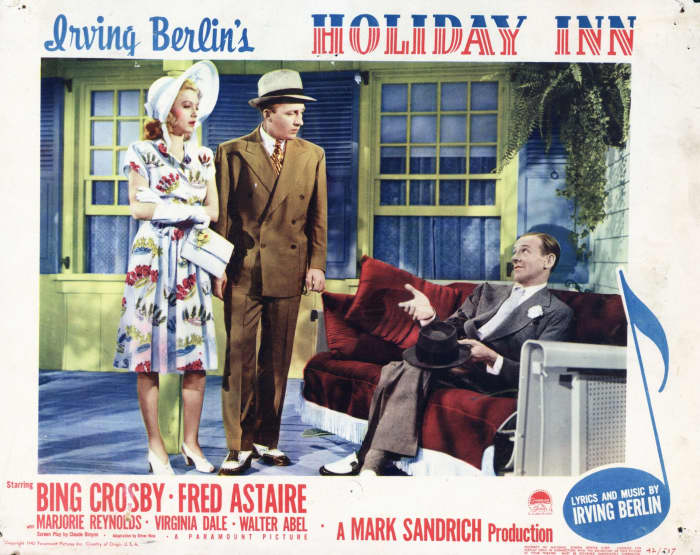
“White Christmas” was written for the musical film Holiday Inn, released in 1942. It won the Academy Award for Best Original Song at the 15th Academy Awards.
PARAMOUNT PICTURES / Ronald Grant Archive / Mary Evans
Many Christmas traditions, including hopes that it will be equal amounts merry and bright and white, can be linked to the cultural preferences of 19th century America. The poem, “A Visit from St. Nicholas,” was published anonymously in the Troy, New York, Sentinel in 1822, according to the New York Historical Society. Often referred to today as “Twas the Night before Christmas,” its stanzas include imagery of newly fallen snow on Christmas Eve.
A few decades later, the popularity of Currier and Ives lithographic prints grew, which contain snowy scenes of American life at the time and “…have become synonymous with the ideal of a classic American Christmas,” according to Ohio Memory, a collaborative project of the Ohio History Connection and the State Library of Ohio.
In more modern times, even London and Dublin gambling houses track odds and collect bets every year on whether or not there will be snowfall on Dec. 25. Current odds say Aberdeen, Scotland, has the best chance for a white Christmas in the U.K. this year.

This map shows the historic probability of there being at least 1 inch of snow on the ground at weather stations across the U.S. on Dec. 25 based on the latest (1991-2020) U.S. Climate Normals from NOAA. Darkest gray shows places where the probability is less than 10% (sorry West Coast, Gulf Coast, Deep South). White shows probabilities greater than 90%.
NOAA/Climate Central
Before you celebrate warmer winters
Holiday cheer aside, there are sobering issues accompanying warmer winters:
Migrating pests: Disease-carrying insects such as mosquitoes and ticks can migrate to regions that were previously too cold to inhabit;
Water supply risk: Warmer winters can lead to declining snowpacks in the West. The recent drought in the region has already shown this impact, with less meltwater that helps refill reservoir levels and irrigate crops in the spring;
Lower fruit yields: Cherry, apple, and peach trees require a minimum number of winter chill hours before they can develop fruit in the subsequent spring and summer months. This chill period is decreasing and could eventually limit fruit development.
Less snow and ice for winter sports: The multi-billion dollar winter recreation industry, which includes skiing, ice fishing and snowmobiling, could take an economic hit because of rising temperatures and less snow and ice accumulation;
For more information on climate change and the snow sports industry, check out Climate Central’s On Thin Ice report, the Protect Our Winters website, or NOAA’s Climate and Skiing report.
For more region-specific data, the National Ski Areas Association has a list of industry statistics to analyze.


